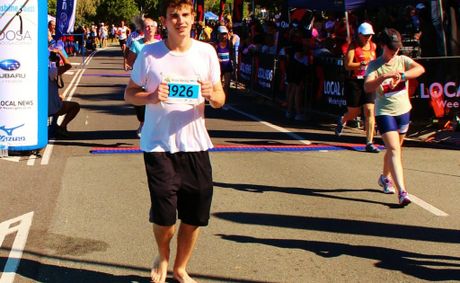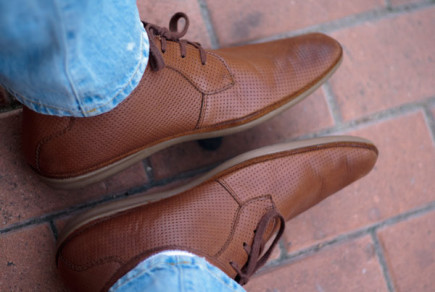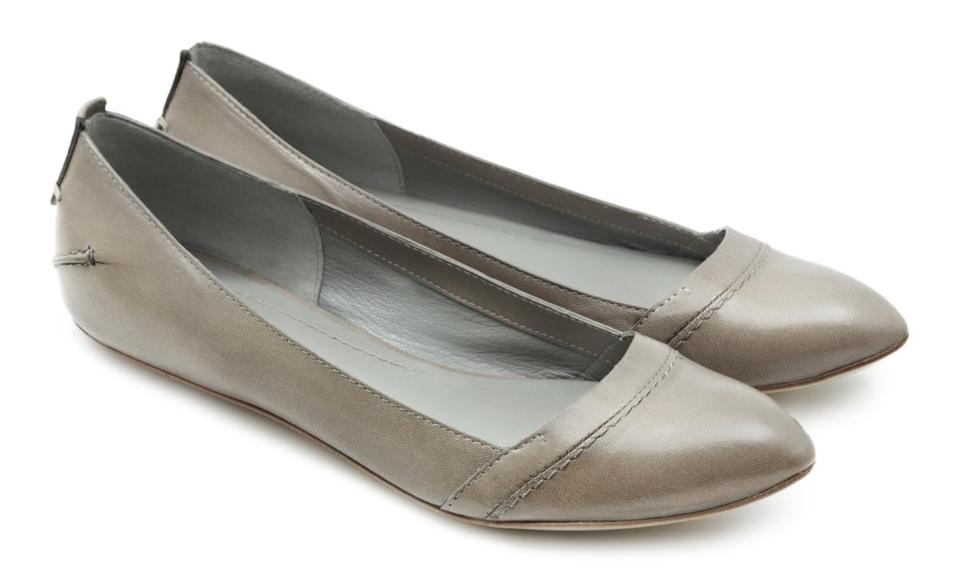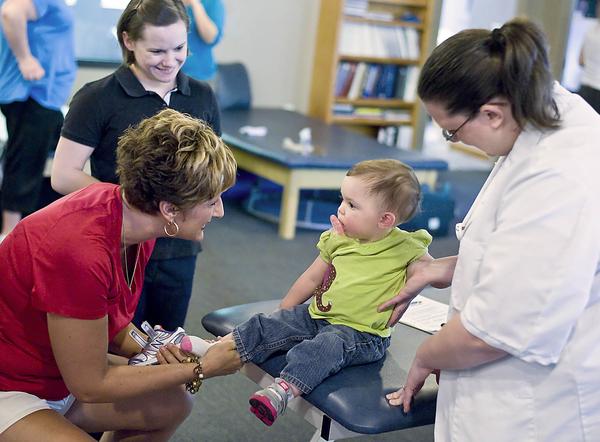Connect With Us
Items filtered by date: May 2013
Young Runner Goes Barefoot to Test Theory
 Brendan Mitchell will be participating in the Noosa Ultimate Sports Fest by testing barefoot running for his new book “The Shoe Conspiracy.”
Brendan Mitchell will be participating in the Noosa Ultimate Sports Fest by testing barefoot running for his new book “The Shoe Conspiracy.”
Film Students from the Queensland School of Technology have teamed up with Mitchell to put this theory to the test. “I just want people to sort of realize we can’t take everything at face value because a shoe salesman says you need a $500 pair of shoes, said 19-year-old Mitchell.” After running the event, Mitchell said his feet felt okay and was not complaining of any injuries.
Allowing your body time to adjust properly to barefoot running is essential, and part of this preventative care involves talking to a podiatrist like Dr. Howard Hyman of The Podiatry Center, P.C Dr. Hyman can advise you on a running regimen, as well as provide information on techniques of barefoot running to help avoid foot pain, heel pain, and injury.
Barefoot Running
Barefoot Running Impact
-Running without shoes changes the motion of your running
-Running barefoot requires landing be done on the front part of the feet as opposed to the heel
Barefoot Running Advantages
-Running and landing on the front feet reduces the impact on the knees and ankles
-It strengthens muscles in the feet and ankles and the lower legs.
-Balance of the body is improved
-Greater sensory input from the feet to the rest of the body.
Barefoot Running Disadvantages
-No protection while running resulting in cuts and bruises if the runner lands on something sharp.
-Blisters may form.
If you have any questions, please feel free to contact our office in Milburn NJ. We offer the newest diagnostic and treatment technologies for all your foot ankle injuries.
Read more on Barefoot Running.
Change up Your Shoes to Avoid Athletes Foot
 According to Deepashri V. of PostNoon.com, wearing the same shoes on a continual basis may increase the risk of athlete’s foot and fungal growth.
According to Deepashri V. of PostNoon.com, wearing the same shoes on a continual basis may increase the risk of athlete’s foot and fungal growth.
Deepashri suggests allowing your feet to breathe in warm weather by wearing open shoes. Also, refrain from wearing thick socks so your feet stay more sanitary and hygienic. “It is very common. Every fourth or fifth person has it. It is very common in those with diabetes and people who always wear shoes, resulting in lack of air circulation to the feet” said Dr. Sunitha Sekhar Reddy, dermatologist at ADI clinics.
Anyone is susceptible in attaining Athlete’s foot, but can be easily avoided following the right preventative care and treatment. A podiatrist like Dr. Howard Hyman of The Podiatry Center, P.C will be able to determine your condition and follow the appropriate treatment options for foot care needs.
What is Athlete’s Foot?
If you suffer from itching, burning, dry, and flaking feet, this may be a sign of athlete's foot. Athlete's foot, also known as tinea pedis, can be extremely contagious, and it often infects shower floors, gyms, socks and shoes, and anywhere else feet may come in contact with. It is commonly found in public changing areas and bathrooms, dormitory style living quarters, around locker rooms and public swimming pools. This condition can also be prevalent in "commons" areas in prisons and residential care facilities.
Solutions to Combat Athlete’s Foot
- Hydrate your feet by using lotion
- Exfoliate
- Buff off nails
- Use of anti-fungal product
- Examine feet and visit your doctor if any suspicious blisters or cuts are present.
What is Tinea?
- Athlete’s foot is often caused by the same fungus that causes ringworm (tinea).
- Tinea can invade other parts of the body as well, if the proper thriving conditions for it are met.
To learn more about Athlete’s foot follow link below.
If you have any questions, please feel free to contact our office in Milburn NJ. We offer the newest diagnostic and treatment technologies for all your foot ankle injuries.
Read more on Athlete’s foot.
Small Heels Are Recommended Over Flats
 People are eager to store away their winter boots and trade them in for their spring sandals and flats now that spring is in the air. On top of this, everyone is looking forward to discovering shoes that properly fit their feet.
People are eager to store away their winter boots and trade them in for their spring sandals and flats now that spring is in the air. On top of this, everyone is looking forward to discovering shoes that properly fit their feet.
However, the shoes that retailers sell have been proven to be dangerous for some shoe-goers; causing problems like tendon injuries and foot pain. In the spring people should always wear a shoe that has a two-inch platform and no more than a three-inch heel, according to Kenneth Leavitt, chief of podiatric medicine at New England Baptist Hospital. “Flat shoes stress the Achilles tendon and cause extensive pronation or flattening of the feet,” Leavitt explained. “Surgery is sometimes warranted for severe, chronic foot pain to fix it.”
It is important that the proper shoes are worn for protection against pain and discomfort. A podiatrist like Dr. Howard Hyman of The Podiatry Center, P.C can make recommendations and help you with any foot pain you might have experienced from wearing ill-fitting footwear.
The Importance of Proper Foot Support
Walking is an everyday function for both men and women, and in order to keep your body’s balance in order, you are going to need shoes that provide the proper kinds of support.
Poor foot support can cause pain and discomfort in the lower back, hips, knees, neck and shoulder. It also can lead to emotional stress, and physiological changes in the body. In order to avoid these problems, you must have proper foot support.
The arch is the most important part of the foot, which is where most of the support and balance of your feet lies. The arch of your foot varies in height, and as you age, this height can change. Proper foot support will help musculoskeletal issues, which causes inactivity or disability.
Shoes to Consider:
- Good heel and arch support
- Have proper length and width for your feet
- Avoid tight/cramped shoes
- Have many eyelets –will give feet better support when the laces are tied
To learn more about proper foot support, please follow link below.
If you have any questions, please feel free to contact our office in Milburn NJ. We offer the newest diagnostic and treatment technologies for all your foot ankle injuries.
Read the full article on Proper Foot Support.
Children’s Feet Made Priority at Sanford Event
 At an event in Sanford, NC; 60 children received shoes donated by New Balance and Aetrex and their parents a free lesson on the importance of proper footwear. According to founder of FootCentric and physical therapist Pat Pande, the importance of healthy feet is often overlooked.
At an event in Sanford, NC; 60 children received shoes donated by New Balance and Aetrex and their parents a free lesson on the importance of proper footwear. According to founder of FootCentric and physical therapist Pat Pande, the importance of healthy feet is often overlooked.
“We want to get kids (proper footwear) while they’re young and before they destroy their feet,” Pande commented, “You’d be surprised how many kids have bad feet by 6 or 7 years old.”
The event was sponsored by FootCentric, and one of a series of events held at least twice per year across the state.
It is very important to keep children’s feet safe and healthy, so be sure to have their feet regularly checked by a podiatrist such as Dr. Howard Hyman of The Podiatry Center, P.C. Dr. Hyman can diagnose any injuries as well as provide treatment options that work for you and your child.
Keeping Children's Feet Healthy
Having healthy feet in childhood can help prevent medical problems later in life, namely in the back and legs. As children grow, their feet require different types of care from birth to school-age.
Although babies do not walk yet, it is still very important to take care of their feet.
- Avoid putting tight shoes or socks on his or her feet
- Allow the baby to stretch and kick his or her feet to feel comfortable
As a toddler, kids are now on the move and begin to develop differently. At this age toddlers are getting a feel for walking, so don’t be alarmed if your toddler is unsteady or ‘walks funny’. Be sure the child wears comfortable and protective shoes so that they can grow into their feet properly.
As your child gets older, it is important to teach them how to take care of their feet
- Show them proper hygiene to prevent infections such as fungus
- Be watchful of any pain or injury
- Have all injuries checked by a doctor as soon as possible
- Comfortable, protective shoes should always be worn, especially at play
To learn more about keeping children’s feet healthy, follow link below.
If you have any questions, please feel free to contact our office in Milburn NJ. We offer the newest diagnostic and treatment technologies for all your foot ankle injuries.
Read more on Keeping Children’s Feet Healthy.
Blog Archives
- April 2025
- March 2025
- February 2025
- January 2025
- December 2024
- November 2024
- October 2024
- September 2024
- August 2024
- July 2024
- June 2024
- May 2024
- April 2024
- March 2024
- February 2024
- January 2024
- December 2023
- November 2023
- October 2023
- September 2023
- August 2023
- July 2023
- June 2023
- May 2023
- April 2023
- March 2023
- February 2023
- January 2023
- December 2022
- November 2022
- October 2022
- September 2022
- August 2022
- July 2022
- June 2022
- May 2022
- April 2022
- March 2022
- February 2022
- January 2022
- December 2021
- November 2021
- October 2021
- September 2021
- August 2021
- July 2021
- June 2021
- May 2021
- April 2021
- March 2021
- February 2021
- January 2021
- December 2020
- November 2020
- October 2020
- September 2020
- August 2020
- July 2020
- June 2020
- May 2020
- April 2020
- March 2020
- February 2020
- January 2020
- December 2019
- November 2019
- October 2019
- September 2019
- August 2019
- July 2019
- June 2019
- May 2019
- April 2019
- March 2019
- February 2019
- January 2019
- December 2018
- November 2018
- October 2018
- September 2018
- August 2018
- July 2018
- June 2018
- May 2018
- April 2018
- March 2018
- February 2018
- January 2018
- December 2017
- November 2017
- October 2017
- September 2017
- August 2017
- July 2017
- June 2017
- May 2017
- April 2017
- March 2017
- February 2017
- January 2017
- December 2016
- November 2016
- October 2016
- September 2016
- August 2016
- July 2016
- June 2016
- May 2016
- April 2016
- March 2016
- February 2016
- January 2016
- December 2015
- November 2015
- October 2015
- September 2015
- August 2015
- July 2015
- June 2015
- May 2015
- January 2014
- December 2013
- November 2013
- October 2013
- September 2013
- August 2013
- July 2013
- June 2013
- May 2013
- April 2013
- March 2013
- February 2013
- January 2013
- December 2012
- November 2012
- October 2012
- September 2012
- August 2012
- July 2012
- June 2012
